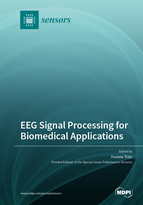EEG Signal Processing for Biomedical Applications
A special issue of Sensors (ISSN 1424-8220). This special issue belongs to the section "Biomedical Sensors".
Deadline for manuscript submissions: closed (28 February 2022) | Viewed by 64942
Special Issue Editor
Interests: biomedical signals; psychophysiology; injury; electroencephalography; heart rate variability; machine learning for rehabilitation medicine
Special Issues, Collections and Topics in MDPI journals
Special Issue Information
Dear Colleagues,
Research focused on brain electrical signals derived from the electroencephalogram (EEG) is gaining traction among researchers from the biomedical, psychology, engineering, and computer science fields. EEG signals have great potential for use in biomedical applications for the diagnosis, treatment, and monitoring of conditions that can alter brain activity, such as mental fatigue. Applications for EEG signals have included the monitoring of brain diseases such as epilepsy, brain tumors, head and spinal injuries, and sleep disorders. Controlling the environment with our mind has always been a wish of humankind. Consequently, assistive technology applications using EEG signals such as brain–computer interfaces (BCI) have been the focus of substantial research, providing a platform for hands-free control. Measuring EEG is reliable, relatively cheap, portable, and non-invasive, making it a key methodology for affordable and effective research, as well as a promising clinical and healthcare tool.
The aim of this Special Issue is to contribute to the current developments pertaining to using EEG signals for biomedical applications. We are inviting submissions of original research, as well as review articles, and new development reports in “Using EEG Signals for Biomedical Applications”.
Topics of interest include (but are not limited to) the following:
- Biomedical applications using EEG signals;
- Assistive technologies using EEG;
- Brain–computer interfaces;
- EEG signal processing;
- EEG for monitoring;
- EEG as a biomarker;
- The influence of conditions such as fatigue on brain activity;
- EEG and sleep.
Dr. Yvonne Tran
Guest Editor
Manuscript Submission Information
Manuscripts should be submitted online at www.mdpi.com by registering and logging in to this website. Once you are registered, click here to go to the submission form. Manuscripts can be submitted until the deadline. All submissions that pass pre-check are peer-reviewed. Accepted papers will be published continuously in the journal (as soon as accepted) and will be listed together on the special issue website. Research articles, review articles as well as short communications are invited. For planned papers, a title and short abstract (about 100 words) can be sent to the Editorial Office for announcement on this website.
Submitted manuscripts should not have been published previously, nor be under consideration for publication elsewhere (except conference proceedings papers). All manuscripts are thoroughly refereed through a single-blind peer-review process. A guide for authors and other relevant information for submission of manuscripts is available on the Instructions for Authors page. Sensors is an international peer-reviewed open access semimonthly journal published by MDPI.
Please visit the Instructions for Authors page before submitting a manuscript. The Article Processing Charge (APC) for publication in this open access journal is 2600 CHF (Swiss Francs). Submitted papers should be well formatted and use good English. Authors may use MDPI's English editing service prior to publication or during author revisions.
Keywords
- EEG signals
- Biomedical applications
- Brain activity
- Brain–computer interface
- EEG biomarkers
- Biomonitoring







